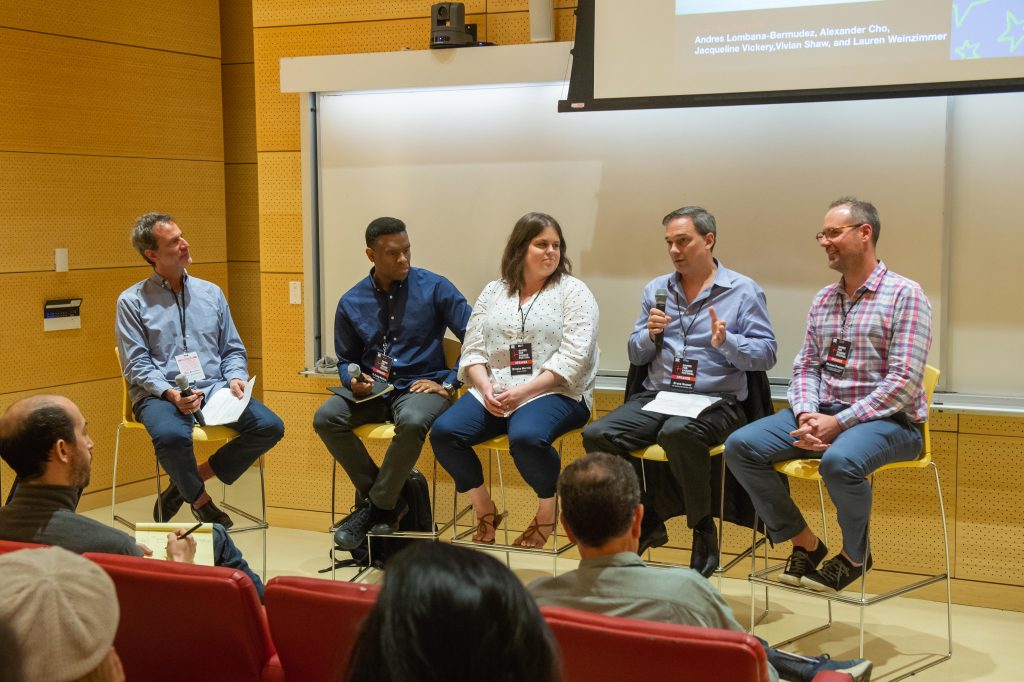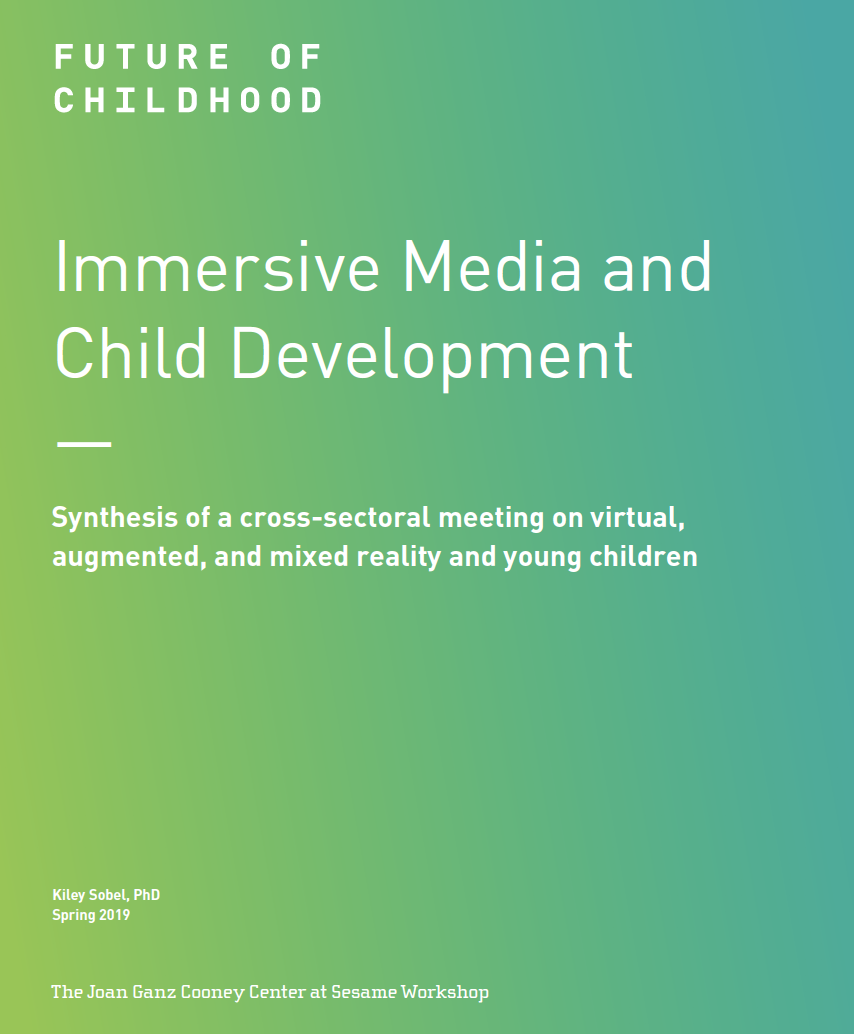At the XR for Change Summit in New York City in June 2019, the Joan Ganz Cooney Center hosted a cross-disciplinary panel of experts to discuss the potential impact and pitfalls of virtual reality (VR) in the classroom. Michael Preston, the Cooney Center’s executive director, kicked off the session with a call to take advantage of VR’s relative youthfulness to ensure that content and hardware developed for learning are beneficial and safe for children. The panel was moderated by David Kleeman, SVP of global trends at Dubit, and featured participants Bruce Homer, director of the Child Interactive Learning and Development (CHILD) Center at CUNY Graduate Center of New York, Brooke Morrill, director of education at Schell Games, and Craig Watkins, founding director of the Institute for Media Innovation at UT Austin.

From left: David Kleeman, Craig S. Watkins, Brooke Morrill, Bruce Homer, and Michael Preston
David Kleeman opened the discussion by noting that while kids are incredibly enthusiastic about VR, that excitement doesn’t appear to last—Dubit’s research showed that when children were provided with PlayStation VR bundles to use at home, the novelty seemed to wear off after a few days and the devices were consigned to the toy bin. Yet in spite of VR’s struggle to sustain children’s engagement at home, this technology presents promising opportunities for learning. Could it be that rather than the consumer market, the VR content and hardware industry should be focusing on the education market? What will it take to make VR viable in the classroom, and not just a novelty to be tried once and cast aside? Can it fulfill educational needs in a cost-effective way?
Here are the key takeaways from the conversation.
Keep in mind the developing child:
Bruce Homer pointed to the importance of keeping in mind that children—the learners—are physical beings, whose cognitive and physical development go hand in hand. When creating content or experiences for children, it is critical to consider things like age, vision development and emotional development, and how those stages affect the activities that children of different ages can do. He also noted that children learn best when they are interacting physically with the world, and VR might create opportunities that standard lesson plans or technologies may not allow.
On the flip side, Homer pointed out that current VR experiences are often isolating; even when a group of students might be experiencing the same VR simulation, they wear individual headsets. Social interactions play an important role in learning, boosting cognitive and emotional skills, especially for young children. It is only now that the technology is beginning to allow people to interact with one another, which might enhance the impact of a VR experience.
Another area that warrants further research is the issue of “reality blurring.” Homer pointed out that although two-year-olds are able to understand the distinction between a story and real life, “it’s a blurry one.” This kind of emotional response is not necessarily limited to young children—he pointed out that even adults feel spooked after watching scary movies late at night. But younger children have a developing sense of self-awareness, and may perceive virtual reality experiences as “more real” than adults do; they may also confuse experiences that they have experienced in virtual reality with their actual experience, creating “false memories.”
When used wisely, VR offers unique learning opportunities:
Brooke Morrill explained that when Schell Games first meets with a client about a new project, they ask, “What platform is this for, and why? Who is the intended audience, what’s the context, what is the goal of this project, and what technology would be best to deliver the intended experience?” Many times, a client comes with an idea for a game in VR, when another platform may be better suited for the desired learning experience. She also pointed out that students are quick to sniff out learning interventions in which traditional worksheets might be thinly disguised through game mechanics, AKA “chocolate-covered broccoli.”
According to Jeremy Bailenson, the founding director of Stanford University’s Virtual Human Interaction Lab, there are only four compelling reasons to use VR. If you actually carried out what you were doing virtually in the physical world, it would be:
- dangerous (e.g., working with harmful materials in a lab),
- impossible (e.g., breaking the laws of physics),
- counterproductive (e.g., cutting down a forest to learn about deforestation), or
- too expensive (e.g., to take a field trip to another country).
Morrill and Homer discussed projects and subject areas in which VR might provide unique opportunities to engage deeply with content that would otherwise not be safe, possible, productive, or cost-effective in the classroom. Homer’s lab is designing a project in which students engage with interactive holograms of molecules and cells, and HoloLab Champions by Schell Games allows students to access a VR chemistry lab. Morrill pointed out that with HoloLab Champions, students learn valuable physical skills like scooping, pouring, and using a balance with chemicals that may be difficult to access or potentially hazardous in real life.
Teachers need support:
A common theme throughout the discussion was the need to provide teachers with professional development materials and training to help them deploy VR successfully with their classes. Brooke Morrill and Bruce Homer agreed that it is critical to offer technical training and support for teachers—even those who are confident with most technologies. Morrill pointed out that “most people don’t have VR at home yet, so we [Schell Games] try to ease that transition by providing some troubleshooting tips.”
Craig Watkins pointed out that in research conducted for his book The Digital Edge, he found that there is a kind of “arms race” to bring more access to technology to classrooms in order to prepare kids for a “knowledge-driven economy” when they graduate. But while the distribution of technology in the classroom is becoming more equitable, many teachers are assigned to teach technology classes despite not being sufficiently prepared to do so.
Watkins found, however, that students often find creative ways to use and share media that were personally meaningful to them. For those self-motivated and entrepreneurial students in “technology-rich but curriculum poor” classrooms, Watkins found that simply having access to equipment and an opportunity to create media offered the opportunity to create and share VR content about specific locations in their communities and engaging with others to share their own experiences.
Redefining assessment:
A successful VR experience for the classroom takes into account a teacher’s need to fulfill a curriculum requirement and to assess a student’s mastery of content or skills, all while actively engaging the learner. In terms of adoption by schools, Michael Preston pointed out that it may take a cultural shift for immersive technologies like VR and AR to be widely adopted in classrooms. Do the experiences that are available align with the curricular content that teachers need to cover, and in ways that cannot be addressed successfully by traditional methods, while allowing a teacher to evaluate learning outcomes in meaningful ways?
Preston suggested that evaluating learning outcomes in VR should reflect the learning goals of the activity, regardless of it being simulated in VR (Is it a field trip or a science experiment? Is it interactive?). Evaluation might also assess students’ understanding of the medium itself. What do learners make of the VR artifact? What was different for them compared to what they’ve experienced in the physical world?
Watkins pointed out that teachers may also want to consider less tangible effects, such as a student’s attitudes towards content before and after a lesson and reflections upon an experience. Providing students opportunities to engage deeply with content that matters to them offers a sense of agency, and that if it were possible to measure these identities pre- and post- engagement with VR interventions, we might find that students feel more empowered by opportunities to experiment with different perspectives.
We’ve got some R&D to do:
The marketplace for virtual reality in education is young: while there is enthusiasm among both students and teachers, we’re at a point where there is still not enough information about these technologies’ potential impact on the health and safety of children under 13. Whether developers are refraining from marketing to young children because of what may be a fairly arbitrary age limit influenced by COPPA, or due to safety concerns that researchers have not yet studied, both researchers and developers have an opportunity to make important contributions to this space. Developers should work with researchers and learning scientists to create immersive learning experiences that are effective and age-appropriate. Careful and strategic efforts now may pave the road for positive, engaging learning opportunities that are safe and empowering for kids.
View the full conversation here:


